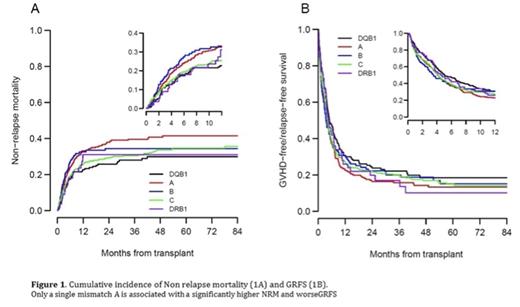Abstract

INTRODUCTION: Matching all alleles of the HLA-A, -B, -C, and -DRB1 loci (8/8 match) is associated with the highest overall survival (OS) rates after unrelated donor (URD) hematopoietic stem cell transplantation (HSCT). In Europe, patients (pts) are also matched at the HLA-DQB1 loci (10/10 match), although there is no evidence of better OS. Data on Caucasian pts receiving a single HLA mismatch URD HSCT are still controversial. We therefore conducted a multicenter retrospective study to assess the impact of a single HLA mismatch (9/10 match) on outcomes after URD HSCT in a large cohort of French pts.
METHODS: We collected data from 1092 pts who underwent HSCT between January 2000 and December 2012 at 32 French transplantation centers. Informed consent was obtained in accordance with the Declaration of Helsinki. High-resolution typing was performed for HLA-A, -B, -C, -DRB1, -DQB1 loci for all donor/recipient pairs. Clinical data were obtained through ProMISe (Project Manager Internet Server), an internet-based system shared by all French transplantation centers. Endpoints of interest were classical HSCT outcomes: engraftment, Graft versus host disease (GvHD), treatment related mortality (TRM) and relapse. GvHD free relapse free survival was also studied (defined as alive with no previous grade III-IV aGvHD, no moderate or severe chronic GvHD (cGvHD) and no relapse). Myeloablative conditioning was defined as a combination of agents expected to produce profound pancytopenia and myeloablation within 1-3 weeks after administration; pancytopenia is long lasting, usually irreversible and in most instances fatal, unless hematopoiesis is restored by hematopoietic stem cell infusion (Bacigalupo, et al.. Biology of Blood and Marrow Transplantation, 2009). Models were adjusted for disease risk, recipient age, CMV and sex matching, stem cell source, GVHD prophylaxis and conditioning regimen. For adjusted analysis DQB1 was used as the reference category. Disease risk was classified as standard or high risk using the American Society for Blood and Marrow Transplantation Request for Information 2006 risk scoring schema.
RESULTS: Population characteristics are shown in Table 1. Gender balance was the only difference between groups (p<0.013). Median follow-up was 84 months. Engraftment rates were not different between groups (overall, 91.8% (95% Confidence interval (CI) (90.1 to 93.4)). Overall Cumulative Incidence of aGVHD grade II-IV and grade III-IV were 39.9% (95% CI, (38.0 to 41.8)) and 22.2% (95% CI, (20.2 to 24.2)), respectively. Myeloablative Conditioning (MAC) using Total Body Irradiation (TBI)>4Gy [Hazard Ratio (HR) HR:1.95 (95% CI, 1.45 to 2.63)] and high disease risk [HR :1.34 (95% CI, 1.09 to 1.66)] were significantly associated with an increased cumulative incidence of grade II-IV aGVHD, whereas only MAC with TBI>4Gy was a risk factor for grade III-IV aGVHD [HR:1.91 (95% CI, 1.28 to 2.87)].Overall Cumulative Incidence of cGVHD was 38.1% (95% CI, 35.9 to 40.1) at 84 months. Overall relapse rate was 33.8% (95% CI, 30.5 to 37.1) with no differences according to HLA mismatch subtype. CI of TRM was 36.0% (95% IC, 32.9 to 39.1). Single HLA-A mismatch [HR:1.55 (95% CI , 1.11 to 2.17)], high disease risk [HR:1.40 (1.12 to 1.74)], a female donor for a male recipient [HR:1.41 (1.10 to 1.79)], and the use of a MAC regimen [HR:1.50 (1.08 to 2.08)] were significantly associated with a higher TRM after adjusted analysis. Overall GRFS was 14.5% (12.1 to 17.3). Single HLA-A mismatch [HR:1.25 (95% IC, 1.01 to 1.54)] and high disease risk [HR:1.45 (95% IC, 1.26 to 1.67)] were significantly associated with a lower GRFS (Figure1).
CONCLUSION: In this large cohort of Caucasian pts who received a single HLA mismatch URD HSCT, high disease risk was the major prognostic factor related to higher rates of both acute GvHD and treatment related mortality, and eventually a lower GRFS. HSCT outcomes were similar according to HLA single mismatches except for HLA-A mismatch, which was associated with a significant increase in TRM, and a worse GFRS. This study also highlights the high rates of both TRM and relapse after single mismatch URD HSCT (9/10) which justifies the use of reduced toxicity conditioning regimens, as well as the addition of targeted therapies pre- and post- HSCT in this setting.
Michallet:Bristol-Myers Squibb: Consultancy, Honoraria, Research Funding; Pfizer: Consultancy, Honoraria; Novartis: Consultancy, Honoraria; Pfizer: Consultancy, Honoraria; Astellas Pharma: Consultancy, Honoraria; MSD: Consultancy, Honoraria; Genzyme: Consultancy, Honoraria. Peffault De Latour:Amgen: Research Funding; Alexion: Consultancy, Honoraria, Research Funding; Pfizer: Consultancy, Honoraria, Research Funding; Novartis: Consultancy, Honoraria, Research Funding.
Author notes
Asterisk with author names denotes non-ASH members.

This icon denotes a clinically relevant abstract



This feature is available to Subscribers Only
Sign In or Create an Account Close Modal